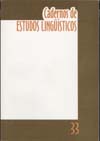Abstract
-
References
ATKINSON, M. (1982) Explanations in the study of child language development. Cambridge: Cambridge University Press.
BONNET, C. & TAMINE-GARDES, J.(1984) Quand l´enfant parle du langage: Connaissance et conscience du langage chez l’enfant. Bruxelles: Pierre Mardaga.
BOWERMAN, M.(1982) Reorganizational processes in lexical and syntactic development. In E. Wanner and L. Gleitman (Eds.) Language Acquisition: The state of the art. Cambridge: CUP (319-345).
CHOMSKY, N.( 1959) A review of B.F. Skinner’s Verbal Behaviour. Language 35 (26-58).
______. (1964/1971) Formal discussion. In Bar-Adon & W.F. Leopold (Eds.) Child Language: A Book of Readings. Englew.ood Cliffs, N.J: Prentice Hall (340-343).
______. (1965) Aspects of the Theory of Syntax. Cambridge:
______. (1976) Reflections on Language. London: Temple Smith.
______. (1986) Knowledge of Language: its Nature, Origin and Use . New York: Praeger.
______. (1995) The Minimalist Program. Cambridge, Mass.: The MIT Press.
CLARK, E.V.(1978) Awareness of Language: Some evidence from what children say and do. In A. Sinclair et al.(Eds.) The Child’s Conception of Language. Berlim: Spinger-Verlag (16-44).
FIGUEIRA, R..A.(1984) On the development of the expression of causativity. a syntactic hypothesis. Journal of Child Language 11 (109-127).
JAKOBSON, R.( 1963) Deux aspects du langage et deux types d’aphasie. In Essais de Linguistique Genérale. Paris: Minuit.
KARMILOFF-SMITH, A.(1986) From meta-processes to conscious access; Evidence from children’s metalinguistic and repair data. Cognition 23 (95-147).
______. (1992) Auto-organizaciíón y cambio cognitivo. Substratum 1 (19-44)
DE LEMOS, C.T.G. (1981) Interactional processes in the child’s construction of language. In W. Deutsch (Ed.) The Child’s Construction of Language. Cambridge: CUP (57-76).
______. (1982) Sobre aquisição de linguagem e seu dilema(pecado) original. Boletim da ABRALIN 3 (96-137).
______. (1992) Los procesos metafóricos y metonímicos como mecanismos de cambio. Substratum 1( 121-135).
______. (1995) Língua e discurso na teorização sobre aquisição de linguagem. Letras de Hoje 102 (29-44).
(forthcoming) Input vs. interpretação. DELTA.
LEVELT, W.J.M., A. SINCLAIR & R.J. JARVELLA(1978) Causes and functions of linguistic awareness in Language Acquisition. In A. Sinclair, R.J. Jarvella & W.J.M.Levelt(Eds.) The Child’s Conception of Language. Berlin: Springer-Verlag (1-16).
LYONS, J.(1977) Semantics I. Cambridge: CUP.
MEISEL, J.M. (1995) Parameters and Acquisition. In P. Fletcher & B. MacWhinney(Eds.) The Handbook of Child Language. Oxford: Blackwell (10-35).
MILNER, J.-CL.(1989) Introduction à une science du langage. Paris: Seuil.
PETERS, A. (1983) The units of language acquisition. New York: CUP.
PINKER, S.(1989) Learnability and Cognition: the Acquisition of Argument Structure. Cambridge, Mass.: The MIT Press.
STRAUSS, S. (1982) U-shaped Behavioural Growth. New York: Academic Press.
VALIAN, V.(1988) Positive evidence, indirect negative evidence, parameter setting and language learning. Unpublished Manuscript. Apud Meisel(1995).
______. (1990) Logical and psychological constraints on the acquisition of syntax. In L. Frazier & J. de Villiers(Eds.) Language Processing and Language Acquisition. Dordrecht: Kluwer (119-145).
WEXLER, K. & CULLICOVER, P.W. (1980) Formal Principles of Language Learning. Cambridge, Mass.: The MIT Press.
The journal CADERNOS DE ESTUDOS LINGUÍSTICOS is granted all the copyright related to the published works. The originals will not be returned. By virtue of being part of this public access journal, the articles are free to use, with their own attributions, in educational and non-commercial applications

